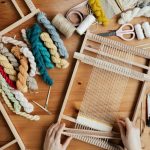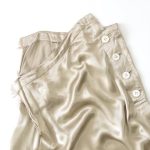You're a fabric artist, weaving together a tapestry of creativity. But those raw fabric edges threaten to unravel your masterpiece. Fear not, for there are 6 ways to seal fabric edges without sewing.
- Fray Check: This handy liquid solution is specifically designed to prevent fabric fraying. Simply apply it to the raw edge, let it dry, and watch as the fraying stops in its tracks.
- Heat Sealing: Using a heat source, such as a lighter or a hot knife, carefully melt the edges of the fabric to create a seal. This method works best with synthetic fabrics that can be melted without damage.
- Fabric Fusion: With fabric glue or adhesive tape, you can bond the raw edges together, creating a strong and durable seal. Be sure to choose a glue that is suitable for your fabric type.
- Pinking Shears: These special scissors have serrated edges that create a zigzag pattern when cutting fabric. By using pinking shears to trim your fabric edges, you can prevent fraying and add a decorative touch.
- Hem Tape: This double-sided adhesive tape is perfect for creating a clean and professional-looking hem. Simply fold the fabric over and secure it in place with the hem tape. It's quick, easy, and requires no sewing.
- Fringe Sealing: If you're dealing with fabric that has a fringe, you can use clear nail polish or fabric glue to seal the ends and prevent them from unraveling.
With this knowledge, you'll confidently tackle any fabric project, leaving your edges flawlessly sealed. So, let's dive in and explore these innovative methods, empowering you to master the art of fabric edge sealing without a single stitch.
Key Takeaways
- Fray Check and seam sealers are convenient, effective, and versatile solutions for sealing fabric edges without sewing.
- Fabric glue and adhesive tape offer practical solutions for fabric sealing without sewing and ensure professional-looking results.
- Heat sealing with a wood burning tool is an effective technique for sealing fabric edges without sewing.
- No-sew edge treatments such as Fray Check, fabric glue, and hemming tape provide quick and effective ways to finish fabric edges without the need for stitching.
Fray Check and Seam Sealers
Use Fray Check or a seam sealer to prevent fraying of fabric edges without the need for sewing. These products offer alternative methods for securing fabric edges, especially when sewing isn't an option or desired.
Fray Check, a liquid seam sealant, is an excellent choice for preventing fraying on raw edges of fabric. It dries clear and flexible, making it suitable for a wide range of fabrics.
Applying Fray Check is simple and effective, offering a DIY solution for those who want to avoid using a sewing machine or hand-sewing. Similarly, seam sealers, available in various forms such as tapes or adhesives, provide another alternative method for securing fabric edges.
These products can be applied quickly and easily, making them practical for a range of projects where traditional sewing may not be feasible. When considering how to seal fabric edges without sewing, Fray Check and seam sealers stand out as convenient, effective, and versatile solutions.
Whether you're working on a quick craft project or seeking a no-sew alternative, these products offer reliable ways to prevent fabric fraying.
Fabric Glue and Adhesive Tape
Fabric adhesives provide a reliable alternative for securing fabric edges without the need for sewing, offering convenience and versatility for various projects. When considering fabric bonding alternatives, hemming options, and non-sewing edge finishes, no sew fabric sealing techniques become essential.
Here are some options to consider:
- Fabric Glue: This type of adhesive is specially formulated for fabric and can bond quickly and securely. It's suitable for hems, patches, and other fabric repairs. Ensure to choose a fabric glue that dries clear and remains flexible after drying.
- Fusible Web Tape: This double-sided adhesive tape allows you to create clean and durable hems without sewing. It requires heat to activate and bond the fabric layers together. It's ideal for lightweight and medium-weight fabrics.
- Iron-On Adhesive Tape: This tape is activated by heat and is perfect for creating permanent bonds between fabrics. It's commonly used for hemming and can be sewn over for added security.
Using fabric glue and adhesive tape offers a practical solution for those seeking no-sew options for fabric sealing while ensuring professional-looking results.
Heat Sealing With a Wood Burning Tool
If you're looking for a no-sew method to seal fabric edges, heat sealing with a wood burning tool is an effective technique worth considering.
This method allows you to neatly seal the edges of your fabric without the need for sewing.
With the right precautions and technique, you can achieve clean and durable edge treatments for your fabric projects.
Wood Burning Tool Technique
How can you effectively seal fabric edges without sewing using a wood burning tool? Heat sealing with a wood burning tool provides a clean and durable edge for fabrics. Here are some tips to master this technique:
- Choose the Right Tool: Invest in a quality wood burning tool with a cone or chisel point for precise heat application.
- Explore Alternatives: If a wood burning tool isn't available, consider using a soldering iron or a hot knife as alternatives.
- Practice Proper Technique: Start by testing the tool on a scrap piece of fabric to understand the heat settings and speed needed for optimal results.
- Master Heat Sealing Techniques: Learn how to smoothly glide the tool along the fabric edge to create a sealed finish without scorching or fraying.
- Ensure Safety: Work in a well-ventilated area, and use protective gear such as heat-resistant gloves to prevent burns.
Mastering the wood burning tool technique for heat sealing fabric edges can elevate your crafting and sewing projects.
Heat-Sealing Fabric Edges
To effectively seal fabric edges without sewing, you can use a wood burning tool for heat sealing. This technique involves carefully running the wood burning tool along the edges of the fabric to melt and seal the fibers, preventing fraying.
One of the main advantages of heat-sealing fabric edges with a wood burning tool is that it creates a durable and long-lasting seal. However, it's important to be cautious as the high temperatures of the tool can easily cause burns or ignite the fabric.
When using this method, ensure you work in a well-ventilated area to avoid inhaling any fumes from the melting fabric. Additionally, always wear protective gloves and eye goggles to prevent accidental burns and eye irritation.
Exercise caution and precision when employing heat-sealing techniques to achieve professional and polished fabric edges.
No-Sew Edge Treatment
When heat-sealing fabric edges with a wood burning tool, carefully run the tool along the edges of the fabric to melt and seal the fibers, preventing fraying. This no-sew hemming technique provides a quick and effective way to finish fabric edges without the need for sewing.
Here are some alternative techniques for fabric finishing and no-sew options:
- Use Fray Check: Apply a small amount of fray check along the fabric edges to prevent fraying.
- Try Fabric Glue: Apply fabric glue along the edges and press them together to create a secure bond.
- Use Hemming Tape: Apply hemming tape to the edges and use an iron to bond the tape to the fabric for a no-sew hemming solution.
These methods offer convenient alternatives for sealing fabric edges without the need for sewing.
Fabric Fusion and Iron-On Adhesives
By using fabric fusion and iron-on adhesives, you can seamlessly seal fabric edges without the need for sewing. These bonding methods offer great alternatives to traditional stitching techniques and have various applications in crafting and garment construction. Fabric fusion involves using a liquid adhesive that creates a strong bond when dried, while iron-on adhesives consist of a heat-activated glue that can be applied with an iron.
| Fabric Fusion | Iron-On Adhesives |
|---|---|
| Liquid adhesive creates strong bond | Heat-activated glue |
| No sewing required | No sewing required |
| Ideal for hems, trims, and appliques | Great for patches, embellishments |
| Permanent bond | Washable and durable |
Fabric fusion is particularly suitable for securing hems, trims, and appliques, providing a permanent bond without the need for stitching. On the other hand, iron-on adhesives are perfect for attaching patches and embellishments, offering a washable and durable alternative to sewing. Both methods are versatile and efficient, allowing you to achieve professional-looking results without a single stitch.
Pinking Shears and Decorative Edge Scissors
Looking to add a decorative touch to your fabric edges without sewing? Pinking shears and decorative edge scissors are the perfect tools for creating unique and professional-looking finishes.
Learn about the basics of pinking shears, explore the options available with decorative edge scissors, and discover the benefits of adding decorative edges to your fabric projects.
Pinking Shears Basics
You can create decorative fabric edges using pinking shears, which are designed to cut fabric with a zigzag pattern. When using pinking shears, it's essential to choose the right pair for your project. Consider the size of the shears, the distance between the teeth, and the material they're made of.
To master pinking shears techniques, practice cutting different fabrics to understand how they behave with the shears. When finishing fabric edges without sewing, pinking shears can be a great alternative. They're ideal for preventing fraying and adding a decorative touch to your projects.
Remember to always keep the shears clean and sharp for the best results. With the right pinking shears, you can achieve professional-looking fabric edges without sewing.
Decorative Edge Scissors Options
How can you achieve decorative fabric edges without sewing using a variety of decorative edge scissors, including pinking shears and other options? Decorative edge scissors offer a unique alternative to sewing for creating finished fabric edges. They come in various designs, allowing you to add creative flair to your projects. Pinking shears, with their zigzag pattern, are a popular choice for preventing fraying and adding a decorative touch. Other decorative edge scissors offer a range of creative designs such as scallops, waves, and more. By using these tools, you can achieve professional-looking, no sew fabric finishes. Explore the table below for a glimpse of the creative designs these scissors can produce.
| Scissor Type | Design Options | Best Use |
|---|---|---|
| Pinking Shears | Zigzag patterns | Preventing fraying and adding decorative touch |
| Scallop Scissors | Scalloped edges | Adding a soft and elegant finish to fabric |
| Wave Edge Scissors | Wavy patterns | Creating a playful and unique fabric edge |
Benefits of Decorative Edges
To achieve professional-looking, no-sew fabric finishes, you can benefit from the unique designs offered by pinking shears and decorative edge scissors, such as scallop and wave patterns. Using these tools provides creative alternatives to traditional fabric edges and unlocks design possibilities that elevate your projects.
Here are some benefits of using decorative edges:
- Versatility: Decorative edge scissors come in various designs, allowing you to experiment with different patterns and textures for a custom look.
- Time-saving: By utilizing pinking shears or decorative edge scissors, you can quickly and effortlessly seal fabric edges without the need for sewing, making your projects more efficient.
- Professional finish: These tools create neat, finished edges that add a touch of sophistication to your fabric crafts, enhancing the overall appeal of your work.
Fabric Edge Binding Tapes
When sealing fabric edges without sewing, consider using fabric edge binding tapes to provide a clean and durable finish. Fabric edge finishing can be achieved through various alternative methods, and utilizing binding tapes is an excellent option for a seamless, professional look.
These tapes offer a no-sew fabric edge technique that's both efficient and aesthetically pleasing. They come in a wide range of colors and materials, allowing for creative options to match your fabric perfectly.
Fabric edge binding tapes are designed to encase the raw edges of fabric, preventing fraying and providing a polished appearance. They're easy to apply and can be used on a variety of fabric types, making them a versatile choice for different projects.
Whether you're working on garments, home decor, or craft projects, binding tapes offer a quick and durable solution for finishing fabric edges without the need for sewing. This method is especially beneficial when working with delicate or intricate fabrics that may not be suitable for traditional sewing techniques.
With fabric edge binding tapes, you can achieve professional-looking results with minimal effort.
Frequently Asked Questions
Can These Methods Be Used to Seal Delicate Fabrics Like Silk or Chiffon?
Yes, adhesive options and heat sealing techniques can be used to seal delicate fabrics like silk or chiffon. They provide a secure bond without the need for sewing, preserving the delicate nature of the fabric.
Will the Sealant or Adhesive Leave a Visible Mark or Residue on the Fabric?
When sealing fabric edges without sewing, adhesive marks can be a concern. However, many sealants and adhesives are designed to leave an invisible residue on the fabric, ensuring a clean and professional finish.
Are These Methods Suitable for Sealing Curved or Intricate Fabric Edges?
When sealing fabric edges without sewing, consider using techniques like fabric glue or adhesive tape for intricate designs. These methods are suitable for curved or intricate fabric edges and can provide a clean and secure seal.
How Durable Are the Sealed Edges When Using These Methods?
To ensure durability when sealing fabric edges without sewing, follow the application process carefully. Utilize suitable methods and products for your specific fabric type. Properly sealed edges can maintain their integrity over time, providing lasting strength and a professional finish.
Can These Methods Be Used on Fabrics That Will Be Washed Frequently?
Frequent washing can affect fabric durability, so consider the fabric type when choosing sealing methods. Some methods may not withstand frequent washing as well as others. Test a small area first to ensure durability.
- Tetron Fabric for Footwear: Style and Durability Guide - June 17, 2025
- Tetron Fabric for Automotive Applications: Durability and Performance - June 17, 2025
- Tetron Fabric for Home Textiles: Uses and Benefits - June 17, 2025







